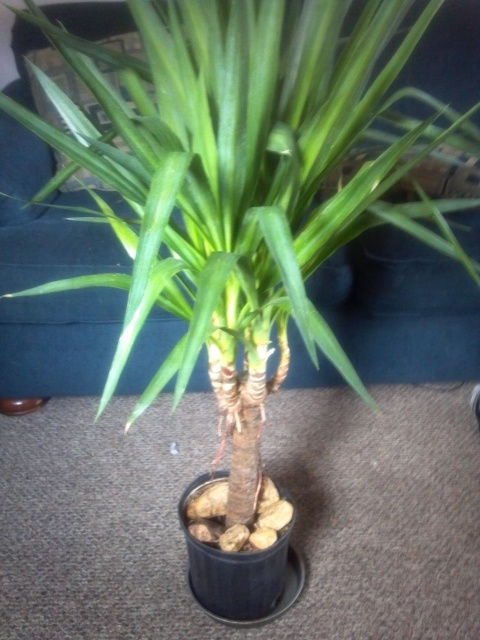Question
 My yucca cane
My yucca cane
Hi there...my mother just bought me a beautiful yucca cane. I am horrible with houseplants so I figured I would ask a few questions so I don't kill it! I read on the tag that it needs high light, and the plant is way to big to be placed on a shelf. I have an eastern facing picture window, but also a large porch awning so the light coming in is decreased alot. Would the plant still be OK in front of this window? I have 2 smaller windows but are pretty high up the wall. My house is really small so places to put this beauty are limited:( I also read that the plant needed to be planted in 3 parts peat moss and 1 part sand. Is this necessary? Or will potting soil be OK? I need to repot it asap, it came in a very flimsy plastic "pot" and it isn't holding up very well. I have never really had any luck with plants and I just love this big guy! I plan on putting the plant outside this spring when it warms up enough, but it will be awhile:(
AnswerHi Nikki,
The eastern picture window is probably going to be the best, out of the available windows you mentioned.
When you put the plant outside in the spring make sure that you place it in the shade, out of direct sunlight.
Potting soil will be just fine for this plant. If you really want, you can use a potting soil specifically made for Cactus but it is not necessary. Just be sure to water the plant properly and any well draining soil will be fine.
For proper watering, as a general rule, allow the top 1-2 inches of soil to dry between watering then water just enough for a small amount of water to drain out of the drainage holes in the bottom of the pot.
The plant is a Dracaena, it is very important that the soil/root ball does not dry out completely, this is fatal to some Dracaena species.
Dracaena are plants that are especially sensitive to the fluoride found in most tap water (as well as chlorine and hard water deposits). They get something called Fluoride toxicity that causes the leaves to turn brown and/or black, starting at the leaf tips. I recommend using distilled water to water the plant. By using distilled water you can avoid the problems that can be caused by water quality.
You should always avoid unnecessary repotting. It is one of the most common reasons for plant failure. Especially when a plant is already stressed from being placed into a new environment. Repotting a new plant within the first month should only be done if absolutely necessary, as in the plant will certainly die if it is not repotted.
A good alternative to repotting is to place the flimsy, plastic pot inside another sturdier pot of the same size (that is called double potting).
A few things to keep in mind for when you do repot. Do not repot until the plant needs to be repotted. Some signs that a plant needs to be repotted is little or no new growth, roots growing out of the drainage holes or sometimes on top of the soil and an almost constant need for water. To check if a plant needs repotted carefully lift the plant out of the pot. If there is little or no soil visible in the root-ball and in the bottom of the pot the plants needs repotted.
Also never repot a plant into a pot that is more than 2 inches bigger than the pot it was in. The soil in a pot that is too big can stay wet too long and cause root rot.
I hope this helps. If you have any questions or need additional information please don't hesitate to ask.
Thanks
Tracy






